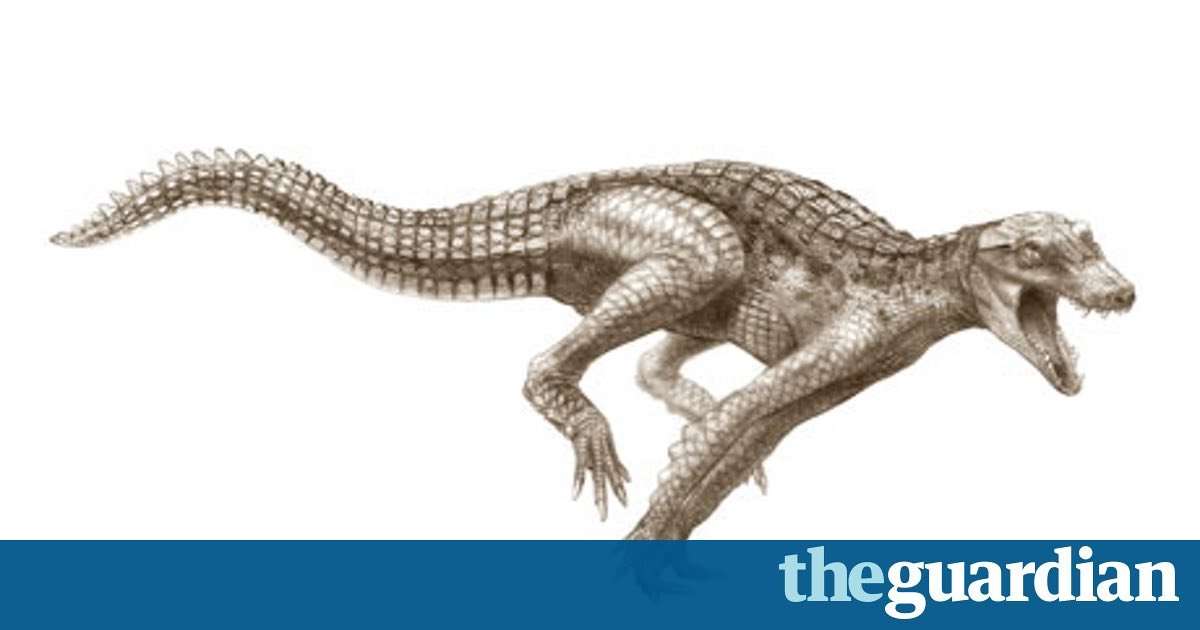The primitive crocodiles, which lived 100m years ago, were good swimmers but were also capable of galloping
Fossil hunters have uncovered the remains of primitive crocodiles that "galloped" on land and patrolled the broad rivers that coursed through north Africa one hundred million years ago.
The skeletons of five creatures that walked with dinosaurs – and ate them – were unearthed in remote and rocky regions of what are now Morocco and Niger during a series of expeditions in the Sahara desert.
Three of the crocodiles are new species and include Kaprosuchus saharicus, a 6.5m-long beast with three sets of dagger-like tusks and an armoured snout for ramming its prey.
Another species, Laganosuchus thaumastos, was of similar length but had a pancake-flat head and is thought to have lurked in rivers with its jaws open, waiting for unsuspecting fish to pass.
The most striking feature the beasts have in common was revealed by their bone structure, which suggests they were efficient swimmers but that when they clambered ashore they were also capable of galloping across the plains. Modern crocodiles crawl on their bellies because their legs sprawl out to the side.
"My African crocs appeared to have had both upright, agile legs for bounding overland and a versatile tail for paddling in water," writes Paul Sereno, a palaeontologist at the University of Chicago, in National Geographic Magazine. "These species open a window on a croc world completely foreign to what was living on northern continents."
The third new species, Araripesuchus rattoides, was only a metre long and probably used a pair of buckteeth in its lower jaw to dig for grubs.
The other two crocodiles unearthed during the expedition are known species. One had a wide, overhanging snout containing sensory areas that it used to sniff out prey in shallow waters. The other had a soft, dog-like nose and is thought to have been extremely agile.
Most of the fossils were found near the site where, in 2001, Sereno uncovered a 12m-long crocodile that lived 110m years ago. The beast, nicknamed SuperCroc, weighed around eight tonnes. The latest fossils are described in the journal ZooKeys.
"We were surprised to find so many species from the same time in the same place," said Hans Larsson, a palaeontologist at the University of Montreal, who took part in the expedition. "Each of the crocs apparently had different diets, different behaviours. It appears they had divided up the ecosystem, each species taking advantage of it in its own way."
The expedition was sponsored by National Geographic, which airs a documentary about the discoveries, When Crocs Ate Dinosaurs, at 5pm on Sunday 20 December on the Nat Geo Wild channel.

RadioIsMyFriend on April 16th, 2017 at 21:21 UTC »
I'm glad nature decided to dial that bullshit down.
sirnumbskull on April 16th, 2017 at 18:31 UTC »
Patch Notes
We Nerfed crocodillian land speed to try to make matches last longer than ten seconds. Hopefully this will give mammals a sporting chance.alexmikli on April 16th, 2017 at 17:53 UTC »
I'm really glad I don't live in a world with galloping acrobatic crocodiles and alligators.